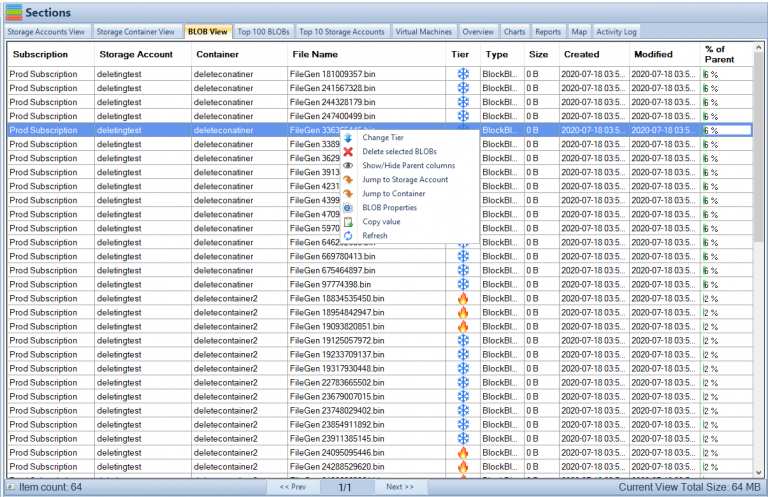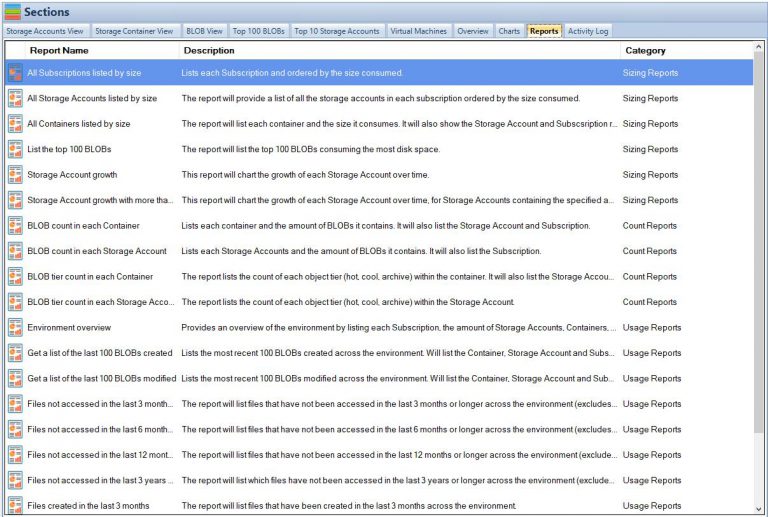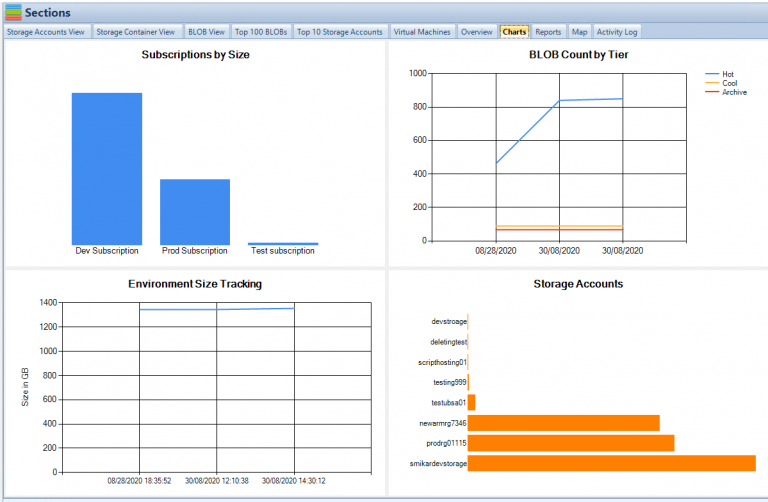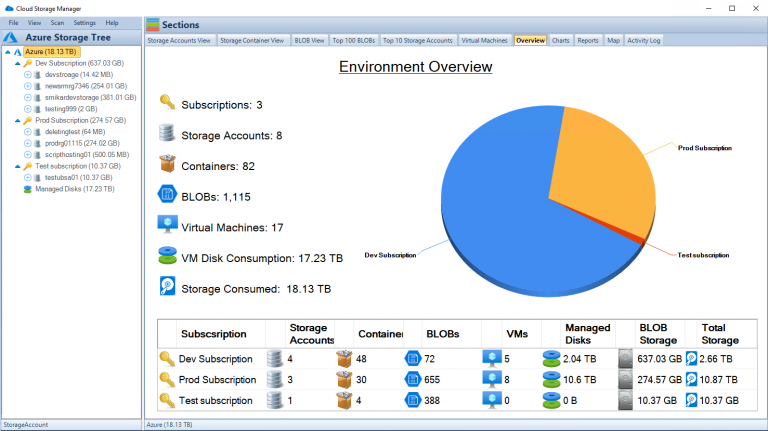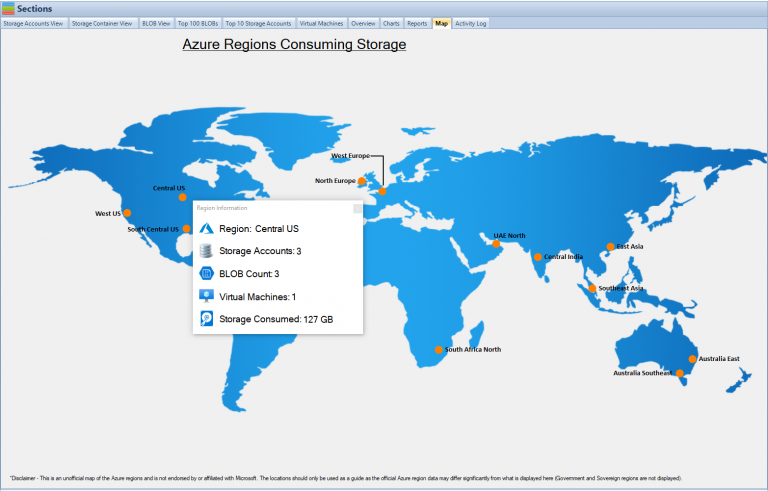
by Mark | Feb 8, 2023 | Azure, Azure Blobs, Azure FIles, Azure Tables, Blob Storage, Storage Accounts
Azure Storage Overview
Azure Storage is a cloud-based storage solution offered by Microsoft. It provides scalable and secure storage for unstructured and structured data, including blobs, files, queues, and tables. With Azure Storage, you can store and access your data from anywhere in the world. The service is flexible and customizable, making it ideal for businesses of all sizes and industries. But, with so many plans and options available, it can be difficult to determine the best plan for your business needs. To help reduce costs and optimize your storage usage, you can use Cloud Storage Manager to analyze your Azure Storage usage and suggest changes. In this article, we will compare the prices and plans of Azure Storage, so you can make an informed decision.
Understanding the Different Plans of Azure Storage
There are several plans available for Azure Storage, each with its own unique features and benefits. The four main plans are:
Blob Storage
Blob Storage is designed for unstructured data, such as images, videos, audio files, and backups. It offers low-cost and high-performance storage for large amounts of data.
File Storage
File Storage is designed for file-based storage and sharing, and it offers high-performance and scalable network storage. It is ideal for cloud-based file shares and applications.
Queue Storage
Queue Storage is designed for message-based communication between applications. It offers a reliable and scalable way to send and receive messages.
Table Storage
Table Storage is designed for structured data, such as tables and NoSQL databases. It offers low-cost and scalable storage for large amounts of data.
Factors That Influence the Cost of Azure Storage
The cost of Azure Storage is influenced by several factors, including:
- Storage capacity: The amount of data you need to store will directly impact the cost of storage.
- Data transfer: The cost of data transfer depends on the amount of data transferred and the location of the data.
- Access patterns: The cost of storage will also depend on how often you access your data and the type of access patterns you use.
How to Compare Prices of Azure Storage Plans
To compare the prices of Azure Storage plans, you need to consider the following factors:
- Storage capacity: Determine the amount of data you need to store and choose a plan that provides enough storage capacity.
- Data transfer: Consider the cost of data transfer and choose a plan that provides the right balance of cost and performance.
- Access patterns: Determine your access patterns and choose a plan that offers the right performance and scalability for your needs.
The Benefits of using Cloud Storage Manager
Cloud Storage Manager can provide you with an in-depth analysis of your Azure Storage usage and help you reduce costs. It can provide insights into your storage utilization, access patterns, and data transfer costs, and suggest changes that can help you optimize your storage usage. With Cloud Storage Manager, you can:
- Monitor your storage usage in real-time
- Analyze your access patterns and data transfer costs
- Identify areas where you can optimize your storage usage
- Implement changes that can help you reduce your storage costs
Azure Storage Frequently Asked Questions (FAQ)
- What is Azure Storage? Azure Storage is a cloud-based storage solution offered by Microsoft. It provides scalable and secure storage for unstructured and structured data, including blobs, files, queues, and tables.
- What are the different plans available for Azure Storage? The four main plans available for Azure Storage are Blob Storage, File Storage, Queue Storage, and Table Storage.
- What factors influence the cost of Azure Storage? The cost of Azure Storage is influenced by factors such as storage capacity, data transfer, and access patterns.
- How can I compare prices of Azure Storage plans? To compare prices of Azure Storage plans, consider factors such as storage capacity, data transfer, and access patterns. Determine the amount of data you need to store, the cost of data transfer, and your access patterns to find the best plan for your needs.
- How can a Cloud Storage Manager help me reduce my costs for Azure Storage? A Cloud Storage Manager can provide an analysis of your Azure Storage usage and suggest changes to help you optimize your storage usage and reduce costs. It can provide insights into storage utilization, access patterns, and data transfer costs, and help you identify areas where you can make changes to reduce your storage costs.
Final Thoughts
Azure Storage is a powerful and flexible cloud-based storage solution that offers scalable and secure storage for unstructured and structured data. By comparing prices and plans, you can find the best plan for your business needs. Cloud Storage Manager can provide you with an analysis of your Azure Storage usage and help you reduce costs by optimizing your storage usage. Whether you need to store large amounts of data, share files, communicate between applications, or store structured data, Azure Storage has a plan that is right for you. So, compare prices and plans of Azure Storage today and find the right solution for your business needs.

by Mark | Feb 6, 2023 | Azure, Azure FIles
Azure File Shares: A Beginner’s Guide
Azure File Shares is a cloud-based file sharing service that provides a secure, scalable, and highly available solution for storing and sharing files in the cloud. With Azure File Shares, you can store, share, and access files from anywhere, at any time, and from any device. Whether you’re a small business owner, a freelancer, or an enterprise-level organization, Azure File Shares can help you meet your file storage and sharing needs.
What are Azure File Shares?
Azure File Shares is a part of the Microsoft Azure platform and is designed to provide a scalable and highly available file storage solution in the cloud. With Azure File Shares, you can store files of any size and type, including documents, images, videos, and audio files. You can also share files with others, either by granting them access to your file share or by sending them a link to the file.
One of the key benefits of Azure File Shares is that it provides a high degree of security. All files stored in Azure File Shares are encrypted at rest, and you can control access to your files by setting permissions. You can also monitor access to your files and audit usage with Azure Activity Logs.
How Does Azure File Shares Work?
Azure File Shares uses the Server Message Block (SMB) protocol to allow users to access files in the cloud. SMB is a standard protocol used for sharing files and printers on a local network. When a user accesses a file share, Azure File Shares uses SMB to connect the user to the file share and allow them to access the files.

Benefits of Azure File Shares
There are many benefits to using Azure File Shares, including:
- Scalability: Azure File Shares can scale to meet the needs of any organization, whether it’s a small business or a large enterprise.
- Accessibility: Azure File Shares allows users to access files from anywhere, at any time, as long as they have an internet connection.
- Collaboration: Azure File Shares makes it easy for multiple users to share files and collaborate on projects.
- Security: Azure File Shares uses industry-standard security measures to protect files and keep them safe from unauthorized access.
Getting Started with Azure File Shares
To get started with Azure File Shares, you’ll need to create an Azure account and sign in to the Azure portal. Once you’re signed in, you can create a new file share by following these steps:
- Click on the “Create a resource” button in the Azure portal.
- Select “Storage” from the list of available resources.
- Choose “Storage account” as the type of storage account you want to create.
- Fill in the required information, such as the name of your storage account, the subscription you want to use, and the resource group you want to use.
- Click the “Create” button to create your storage account.
Once your storage account is created, you can create a new file share by following these steps:
- Navigate to your storage account in the Azure portal.
- Click on the “File shares” option in the left-side menu.
- Click the “Add” button to create a new file share.
- Fill in the required information, such as the name of your file share and the quota for the file share.
- Click the “Create” button to create your file share.
Storing and Sharing Files in Azure File Shares
With Azure File Shares, you can store and share files in a number of different ways. Here are a few of the most common ways to store and share files in Azure File Shares:
Storing Files
To store files in Azure File Shares, you can simply drag and drop files into your file share in the Azure portal, or you can use the Azure File Share REST API to programmatically upload files. You can also use the Azure File Sync service to synchronize your on-premises file servers with your Azure File Shares, allowing you to store and access your files from anywhere.
Alternatively, you can map a drive from your server or workstation so you can access all the file directly.
Analyzing Azure File Shares
To really optimize the cost of your cloud storage and make sure you’re not wasting money on unnecessary files, you need to have a good understanding of what files or blobs have or have not been used.
This is where Cloud Storage Manager comes in. Cloud Storage Manager is a software that provides analytics of both Azure Blob and File storage, allowing the user to see which files or blobs have or have not been used, so that they can reduce the cost of their cloud storage. With this software, you can easily identify and delete unnecessary files to save on storage costs.
To learn more about Cloud Storage Manager and start optimizing your Azure File Shares, visit https://www.smikar.com/cloud-storage-manager/

What are the limitations of Azure File Shares?
- Maximum file size: The maximum size for a single file in an Azure File Share is 1 TB.
- Maximum file share size: The maximum size for an Azure File Share is 5 TiB (5,120 GB).
- Maximum IOPS per share: A single Azure File Share can support up to 1000 IOPS (input/output operations per second).
- Maximum throughput per share: A single Azure File Share can support up to 60 MB/s (megabytes per second) of throughput.
- Maximum number of files: The maximum number of files that can be stored in an Azure File Share is not limited by Azure. However, the performance of the file share may be impacted by a large number of small files.
- Limitations on filenames and path length: Azure File Shares have restrictions on the length of filenames and paths. Filenames must be between 1 and 255 characters in length, and the total length of the path to the file (including the share name, directories, and filename) must be less than 4096 characters.
- Limitations on naming conventions: Azure File Shares have restrictions on naming conventions for files and directories. Names cannot contain certain special characters and names must be unique within a directory.
Conclusion
In conclusion, Azure File Shares is a highly beneficial and cost-effective solution for businesses and individuals who require cloud storage. With its scalability, reliability, and security features, it offers a comprehensive solution for storing, accessing and sharing files. Whether you’re a small business, a large corporation, or an individual, Azure File Shares can help you store and manage your data in the cloud.
Read our further blog posts on Azure Files, from saving money, or what are Azure files.
If you’re looking to optimize your Azure storage costs, it’s essential to have a tool that can help you monitor your usage and identify unused files or blobs. This is where Cloud Storage Manager comes in, providing analytics of both Azure Blob and File storage, allowing you to see what files or blobs have or have not been used, to reduce the cost of your cloud storage.
So, if you’re looking for an easy-to-use and cost-effective solution for storing and managing your data in the cloud, Azure File Shares is the perfect choice. And if you want to take it a step further and optimize your Azure storage costs, be sure to check out Cloud Storage Manager at https://www.smikar.com/cloud-storage-manager/.

by Mark | Feb 5, 2023 | Azure, Azure Tables
Azure Tables overview
Azure Tables is a NoSQL cloud-based data storage service provided by Microsoft. It allows users to store and retrieve structured data in the cloud, and it is designed to be highly scalable and cost-effective.
Azure Tables are used for a variety of purposes, including:
- Storing large amounts of structured data: Azure Tables are designed to store large amounts of structured data, making it a good option for big data workloads.
- Building highly scalable applications: Azure Tables are highly scalable, making it a good option for building applications that need to handle a large number of users or requests.
- Storing semi-structured data: Azure Tables can store semi-structured data, making it a good option for storing data that doesn’t fit well in a traditional relational database.
- Storing metadata: Azure Tables are commonly used to store metadata, such as the properties of a file or image.
- Storing log data: Azure Tables can be used to store log data, that can be later used for analysis and troubleshooting.
- Storing session data for Web application: Azure Tables can be used as a session state provider for web applications
- Storing non-relational data: Azure Tables is good for storing non-relational data, such as data from IoT devices, mobile apps, and social media platforms.
- Storing hierarchical data: Azure tables can be used to store hierarchical data, such as data from a tree-like structure.
In summary, Azure Tables are a cost-effective, highly scalable, and flexible data storage service that is well suited for storing large amounts of structured and semi-structured data. It can be used for different purposes and can be integrated easily with other Azure services.
What are the best practices when using Azure Tables?
When using Azure Tables, it’s important to follow best practices to ensure that your data is stored efficiently, securely, and cost-effectively. Some best practices to keep in mind include:
- Use partition keys and row keys effectively: When designing your Azure Tables, it’s important to choose appropriate partition keys and row keys to ensure that your data is stored efficiently. This will ensure that your data is spread across multiple storage nodes, which can help to improve performance and reduce costs.
- Use indexing: Azure Tables supports indexing, which can help to improve the performance of queries and reduce the number of requests made to the service. Be mindful of the cost of indexing and the size of the index.
- Use batch operations: Azure Tables allows you to perform batch operations, which can help to reduce the number of requests made to the service and improve performance.
- Use the appropriate storage tier: Azure Tables offers several storage tiers, including the standard storage tier, and the premium storage tier. Choosing the appropriate storage tier for your workload can help to reduce costs.
- Use Azure’s built-in security features: Azure Tables includes built-in security features such as Azure Active Directory (AAD) authentication, and access controls that can be used to secure your data.
- Use Azure’s built-in cost optimization tools: Azure provides a number of built-in tools that can help you optimize your storage costs, such as the Azure Cost Management tool.
- Monitor and analyze usage metrics: To ensure that your Azure Tables are being used efficiently and effectively, it’s important to monitor and analyze usage metrics such as storage usage, request rate, and error rate.
- backup your data: it’s important to backup your data to avoid data loss and to have a disaster recovery plan.
By following these best practices, you can ensure that your Azure Tables are used efficiently, securely, and cost-effectively.
How to further save money with Azure Tables:
- Use Azure Reserved Instances: Reserved Instances allow you to pre-pay for a certain amount of storage for a period of time, which can result in significant savings.
- Use Azure’s pay-as-you-go pricing model: Azure’s pay-as-you-go pricing model allows you to only pay for the storage that you actually use. This can be a cost-effective option for users who don’t need a large amount of storage.
- Take advantage of Azure’s free trial: Azure offers a free trial that allows users to test out the service before committing to a paid subscription.
- Use Azure cool storage for infrequently accessed data: By using Azure cool storage for infrequently accessed data, you can reduce the cost of storing that data.
Azure Tables conclusion
Azure Tables is a NoSQL data storage service that allows users to store and retrieve structured data in the cloud. It is designed to be highly scalable and cost-effective. By understanding the different storage options available, using Azure Data Box, and taking advantage of Azure’s built-in cost optimization tools, users can efficiently reduce

by Mark | Feb 3, 2023 | Azure, Azure Blobs, Blob Storage, Comparison
Introduction
Azure Data Lake Storage Gen2 and Blob storage are two cloud storage solutions offered by Microsoft Azure. While both solutions are designed to store and manage large amounts of data, there are several key differences between them. This article will explain the differences and help you choose the right solution for your cloud data management needs.

Understanding Azure Data Lake Storage Gen2
Azure Data Lake Storage Gen2 is an enterprise-level, hyper-scale data lake solution. It is designed to handle massive amounts of data for big data analytics and machine learning scenarios. It combines the scalability of Azure Blob Storage with the file system capabilities of Hadoop Distributed File System (HDFS). It’s a fully managed service that supports HDFS, Apache Spark, Hive, and other big data frameworks. Data Lake Storage Gen2 offers the following features:
- Hierarchical namespace: Allows for a more organized and efficient data structure.
- High scalability: Can handle petabytes of data and millions of transactions per second.
- Advanced analytics: Provides integrations with big data frameworks, making it easier to perform advanced analytics.
- Tiered storage: Enables the use of hot, cool, and archive storage tiers, providing flexibility in storage options and cost savings.
Understanding Blob storage
Azure Blob Storage is a cloud-based object storage solution. It’s designed for storing and retrieving unstructured data, such as images, videos, audio files, and documents. Blob Storage is a scalable and cost-effective solution for businesses of all sizes. Blob Storage offers the following features:
- Multiple access tiers: Offers hot, cool, and archive storage tiers, allowing businesses to choose the right storage tier for their needs.
- High scalability: Can handle petabytes of data and millions of transactions per second.
- Data redundancy: Provides data redundancy across multiple data centers, ensuring data availability and durability.
- Integration with Azure services: Integrates with other Azure services, such as Azure Functions and Azure Stream Analytics.

Differences between Azure Data Lake Storage Gen2 and Blob storage
Now that we have explored the features and benefits of both Azure Data Lake Storage Gen2 and Azure Blob Storage, let’s compare the two.
Data Structure
Azure Data Lake Storage Gen2 has a hierarchical namespace, which allows for a more organized and efficient data structure. It means that data can be stored in a more structured manner, and files can be easily accessed and managed. On the other hand, Azure Blob Storage does not have a hierarchical namespace, and data is stored in a flat structure. It can make data management more challenging, but it’s a simpler approach for businesses that don’t require complex data structures.
Data Analytics
Azure Data Lake Storage Gen2 is designed specifically for big data analytics and machine learning scenarios. It supports integrations with big data frameworks, such as Apache Spark, Hadoop, and Hive. On the other hand, Azure Blob Storage is designed for storing unstructured data, and it doesn’t have built-in analytics capabilities. However, businesses can use other Azure services, such as Azure Databricks, to perform advanced analytics.
Cost
Both Azure Data Lake Storage Gen2 and Azure Blob Storage offer tiered storage, providing flexibility in storage options and cost savings. However, the storage costs for Data Lake Storage Gen2 are slightly higher than Blob Storage.
To minimise costs of both Azure Datalake and Azure Blob Storage, you can use Cloud Storage Manager to understand exactly what data is being accessed, or more importantly not being accessed, and where you can possibly save money.

Performance
Azure Data Lake Storage Gen2 offers faster data access and improved query performance compared to Azure Blob Storage. This is because Data Lake Storage Gen2 is optimized for big data analytics and can handle complex queries more efficiently. However, if your business doesn’t require advanced analytics, Blob Storage may be a more cost-effective option.
Use Cases
Azure Data Lake Storage Gen2 is an ideal choice for businesses that require big data analytics and machine learning capabilities. It’s a suitable option for data scientists, analysts, and developers who work with large datasets. On the other hand, Azure Blob Storage is best suited for storing and retrieving unstructured data, such as media files and documents. It’s an ideal option for businesses that need to store and share data with their clients or partners.
Conclusion
In conclusion, Azure Data Lake Storage Gen2 and Blob storage are both cloud storage solutions offered by Microsoft Azure. While both solutions are designed to store and manage data, there are several key differences between them, including scalability, cost, performance, security, and use cases. When choosing between Azure Data Lake Storage Gen2 and Blob storage, consider your data storage needs and choose the solution that best meets those needs.
In summary, Azure Data Lake Storage Gen2 is ideal for big data analytics workloads, while Blob storage is ideal for storing and accessing unstructured data. Both solutions offer strong security features and are cost-effective compared to traditional data storage solutions.
FAQs
Can I use Azure Blob Storage for big data analytics?
Yes, you can use other Azure services, such as Azure Databricks, to perform advanced analytics on data stored in Azure Blob Storage.
Can I use Azure Data Lake Storage Gen2 for storing unstructured data?
Yes, you can use Data Lake Storage Gen2 to store unstructured data, but it’s optimized for structured and semi-structured data.
How does the cost of Data Lake Storage Gen2 compare to Blob Storage?
The storage costs for Data Lake Storage Gen2 are slightly higher than Blob Storage due to its advanced analytics capabilities.
Can I integrate Azure Blob Storage with other Azure services?
Yes, Azure Blob Storage integrates with other Azure services, such as Azure Functions and Azure Stream Analytics.
Is Azure Storage suitable for businesses of all sizes?
Yes, Azure Storage is a scalable and cost-effective solution suitable for businesses of all sizes.
Can you reduce the costs of Azure Blob Storage and Azure Datalake?
Yes, simply using Cloud Storage Manager to understand growth trends, data that is redundant, and what can be moved to a lower storage tier.

by Mark | Jan 25, 2023 | Azure, Azure Blobs, Blob Storage
Azure storage accounts offer powerful, cost-effective options for managing your data and applications. With various services such as blobs, queues, files, and tables, you can use Azure Storage to store and access virtually limitless amounts of data effectively. This guide will walk you through all the basics of setting up and using an Azure Storage Account.
What is Azure Storage and How Does It Work?
Azure storage consists of durable, conveniently located and cost-effective cloud storage services. It offers a range of storage options to accommodate different budget and performance needs. Data stored in Azure Storage can be accessed via various protocols, such as HTTP/HTTPS for web applications and SMB for applications running on Windows Virtual Machines. Additionally, Azure Storage is secure, compliant with global standards, redundant and scalable.
Azure Storage is a cloud-based service provided by Microsoft Azure for storing and managing unstructured data, such as binary files, text files, and media files. Azure Storage includes several different storage options, including Azure Blob storage, Azure File storage, Azure Queue storage, and Azure Table storage.
Azure Blob storage is designed for unstructured data and is optimized for storing large amounts of unstructured data, such as text or binary data. Blobs can be in several formats like block blobs, page blobs and append blobs.
Azure File storage is a service that allows you to create file shares in the cloud, accessible from any SMB 3.0 compliant client.
Azure Queue storage is a service for storing and retrieving messages in a queue, used to exchange messages between components of a distributed application.
Azure Table storage is a service for storing and querying structured NoSQL data in the form of a key-value store.
All of these services allows you to store and retrieve data in the cloud using standard REST and SDK APIs, and they can be accessed from anywhere in the world via HTTP or HTTPS.
Azure Storage also provides built-in redundancy and automatically replicates data to ensure that it is always available, even in the event of an outage. It also provides automatic load balancing and offers built-in data protection, data archiving, and data retention options. With the use of Shared Access Signatures (SAS) you can control who and when can access the stored data.
In summary, Azure Storage is a set of services that enables the ability to store and manage unstructured data in the cloud, providing various storage options, accessibility, and built-in redundancy, security, and management features.
Managing Your Storage Accounts in Azure
Azure storage consists of durable, conveniently located and cost-effective cloud storage services. It offers a range of storage options to accommodate different budget and performance needs. Data stored in Azure Storage can be accessed via various protocols, such as HTTP/HTTPS for web applications and SMB for applications running on Windows Virtual Machines. Additionally, Azure Storage is secure, compliant with global standards, redundant and scalable.
Managing your storage accounts in Azure involves several different tasks, such as creating and configuring storage accounts, setting up access control, monitoring and troubleshooting storage accounts, and managing data stored in the accounts.
To create a new storage account, you can use the Azure portal, Azure CLI, or Azure PowerShell. Once the storage account is created, you can configure it by setting up access control, creating containers or file shares, and configuring data replication, encryption, and backup options.
Access control in Azure Storage is managed using shared access signatures (SAS) and Azure Active Directory (AAD) authentication. SAS allow you to control access to specific resources within a storage account, and can be used to grant time-limited access to specific users or applications. AAD authentication allows you to secure your storage accounts by requiring users to sign in with their Azure AD credentials.
Monitoring and troubleshooting storage accounts can be done using Azure Monitor, Azure Log Analytics and Azure Storage Analytics. Azure Monitor provides real-time telemetry and alerts, while Azure Log Analytics enables you to analyze and troubleshoot issues by querying logs and metrics. Azure Storage Analytics provide usage metrics, diagnostic logs and operation logs for your storage account.
Finally, managing data stored in your storage accounts can be done using Azure Storage Explorer, Azure CLI, and Azure PowerShell. Azure Storage Explorer provides a graphical user interface for managing data stored in your storage accounts, while Azure CLI and Azure PowerShell provide command-line interfaces for managing data.
In summary, managing storage accounts in Azure involves creating and configuring storage accounts, setting up access control, monitoring and troubleshooting storage accounts, and managing data stored in the accounts, with the help of a variety of Azure tools like Azure Monitor, Azure Log Analytics, Azure Storage Analytics, Azure Storage Explorer, Azure CLI and Azure PowerShell.
Overview of the Different Types of Storage Services
Azure Storage is an efficient and cost effective way to store data in the cloud. You can choose from a variety of storage services, each designed for a different purpose. These include blob storage for objects such as images, videos, and audio; file storage for shared access files and folders; table storage NoSQL key-value pairs; queue storage queues used to facilitate message communication between applications; and disk storage virtual disks used to create VMs.
Azure Storage provides several different types of storage services, each optimized for different types of data and use cases. These services include:
- Azure Blob Storage: This is object storage for unstructured data, such as text or binary files, images, and videos. Blob storage allows you to store and access large amounts of unstructured data, and is designed for scalability and high availability. It support 3 types of blobs: Block Blobs, Page Blobs and Append Blobs
- Azure File Storage: This service allows you to create file shares in the cloud that can be accessed using the SMB protocol, making it easy to work with file-based data using standard file system APIs. This service can be useful for scenarios where you need to share files among multiple VMs.
- Azure Queue Storage: This service provides a message queue that can be used to exchange messages between components of a distributed application. This can be useful for scenarios where you need to reliably send messages between different parts of your application.
- Azure Table Storage: This service provides a NoSQL data store that can be used to store and retrieve structured data in the form of key-value pairs. This can be useful for scenarios where you need to store and retrieve large amounts of structured data that doesn’t need to be queried with full-text search or join operations.
- Azure Disks and Disk Snapshots: These services allow you to create and manage virtual hard disks (VHDs) in Azure, which can be used to store persistent data for Azure VMs. You can also take snapshots of a disk, which allows you to take a point-in-time copy of the disk and use it to restore the disk or create new disks.
All these services are built on top of Azure Storage infrastructure and share common features like automatic replication, durability, high availability and can be managed via Azure portal, Azure Storage Explorer, Azure CLI and Azure PowerShell.
As always, there are limitations to technology. Azure Storage is no different, read this post to understand the Azure Storage limitations.
Using Blobs to Store Binary Data
Block blobs are used to store binary data, such as images, videos, documents and application installers. They allow you to upload large amounts of data and can support up to 195GB in size. Blob storage is a great way to store static objects like images or videos that your applications may need to access. Each file or block is stored as an atomic unit, meaning once uploaded the data cannot be further changed or modified.
Azure Blob storage is a service that can be used to store binary data, such as text or binary files, images, and videos. Blob storage supports three types of blobs: block blobs, page blobs, and append blobs.
Block blobs are the most common type of blob and are optimized for streaming. They can be used to store files such as images, videos, and documents. Each block blob can be up to 200 GB in size.
Page blobs are similar to block blobs, but they are optimized for random read and write operations. They can be used to store files such as virtual hard disks (VHDs) and SQL database files. Each page blob can be up to 8 TB in size.
Append blobs are similar to block blobs, but they are optimized for append operations. They are used to store log files and other data that is appended to over time. Each append blob can be up to 195 GB in size.
In order to store binary data in Azure Blob Storage, you can use the Azure Storage SDKs, Azure Storage REST API, or Azure Storage Explorer. You can upload data to a blob using the Put Blob operation, and you can download data from a blob using the Get Blob operation.
Once the data is in the blob, you can set permissions on the blob, set metadata, and even generate shared access signatures (SAS) to allow others to access the data with a specific set of permissions.
Additionally, you can use features like lifecycle management, geo-redundancy, encryption, and backups to ensure the data is protected and can be easily accessed and managed.
In summary, Azure Blob storage is a cost-effective, scalable, and highly available service for storing unstructured data, it provides three different types of blob storage tailored for specific use cases and scenarios, and it can be easily integrated with other Azure services for data management, security, backup and disaster recovery.
Understanding Tables, Queues & Files for Storage Operations
Tables are used to store structured non-relational data in a NoSQL format, meaning you can store large amounts of data without any predefined structure. This type of storage is an excellent option for applications that feed off large volumes of data and require rapid access, such as gaming and analytics applications. Queues are the perfect choice if you need to queue up messages or tasks and have them read by multiple receivers. Finally, files can be used to store disk level files or images that your application might need to read or write. All files stored in the file service are accessible via either REST API or SMB protocol.
Azure Storage includes several different services for storing and managing data, including Azure Table storage, Azure Queue storage, and Azure File storage. Each of these services is optimized for different types of data and use cases.
Azure Table storage is a NoSQL data store that can be used to store structured data in the form of key-value pairs. It is designed for storing large amounts of structured data that doesn’t need to be queried with full-text search or join operations. It is well suited for storing semi-structured data that doesn’t fit a traditional relational schema, or for storing metadata or log data.
Azure Queue storage is a service that provides a message queue that can be used to exchange messages between components of a distributed application. Queue storage can be used for reliable messaging between different parts of your application, for example, between a web frontend and backend worker roles, it allows you to decouple the components of your application.
Azure File storage is a service that allows you to create file shares in the cloud that can be accessed using the SMB protocol, making it easy to work with file-based data using standard file system APIs. Azure File Storage is a great fit for scenarios where you need to share files among multiple VMs, for example, when you have a distributed application.
In summary, Azure Table storage is designed for storing structured data, Azure Queue storage is designed for messaging, and Azure File storage is designed for file-based storage. Each service is optimized for different use cases and can be used together to create a complete data storage and management solution in Azure.
Now hopefully you understand a little bit more about Azure Storage and its various services. If you are using Azure Storage and need to gather insights in to your Storage Consumption, have a look and download a free trial of Cloud Storage Manager.



